University Assignment: Infant and Toddler Development and Care
VerifiedAdded on 2022/08/24
|15
|3504
|11
Homework Assignment
AI Summary
This assignment delves into the multifaceted aspects of infant and toddler development and care, encompassing vision statements, self-regulation strategies, developmental theories, and curriculum design. The student explores a vision statement for infant and toddler programs, followed by an analysis of a child's self-regulation challenges and strategies to promote it, alongside collaboration with the child's family. The assignment further examines various theories of development, including sociocultural theory, attachment theory, constructivist learning, perceptual mapping of language, and motor learning development, with practical applications and examples. The final section focuses on creating a developmentally appropriate curriculum, addressing cultural sensitivities and incorporating parental expectations. The assignment provides a comprehensive overview of key concepts and practical applications in early childhood education.
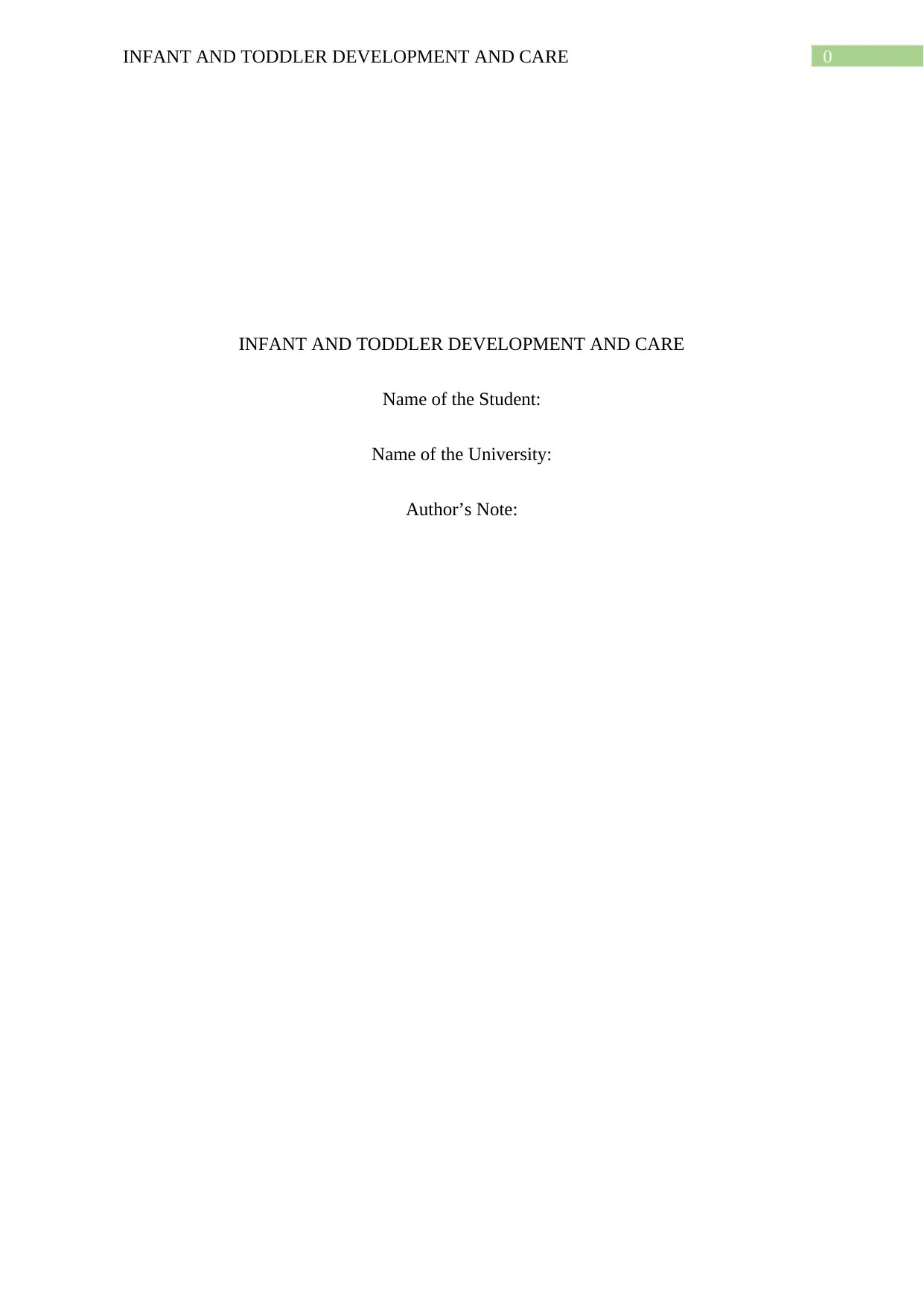
0INFANT AND TODDLER DEVELOPMENT AND CARE
INFANT AND TODDLER DEVELOPMENT AND CARE
Name of the Student:
Name of the University:
Author’s Note:
INFANT AND TODDLER DEVELOPMENT AND CARE
Name of the Student:
Name of the University:
Author’s Note:
Paraphrase This Document
Need a fresh take? Get an instant paraphrase of this document with our AI Paraphraser
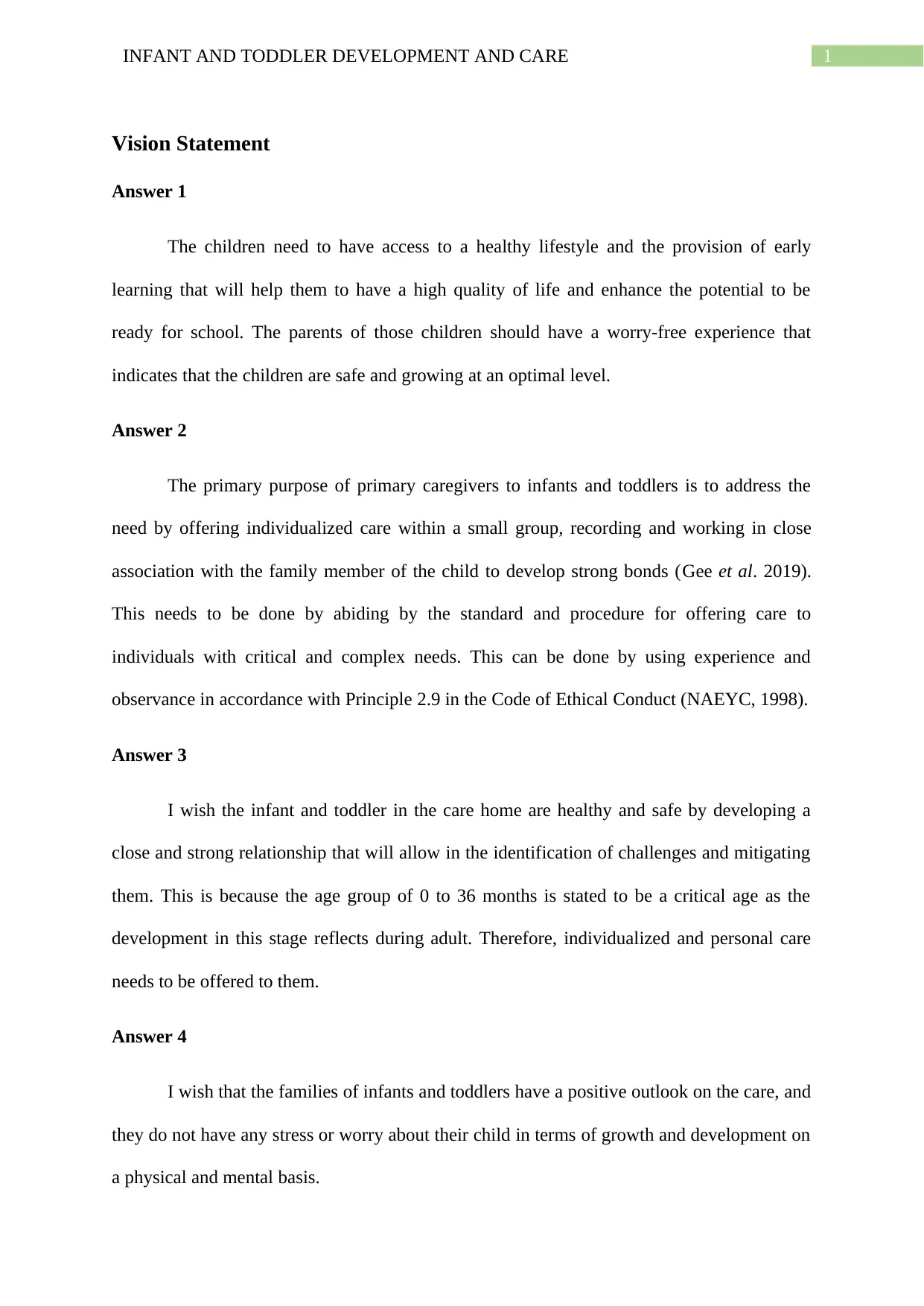
1INFANT AND TODDLER DEVELOPMENT AND CARE
Vision Statement
Answer 1
The children need to have access to a healthy lifestyle and the provision of early
learning that will help them to have a high quality of life and enhance the potential to be
ready for school. The parents of those children should have a worry-free experience that
indicates that the children are safe and growing at an optimal level.
Answer 2
The primary purpose of primary caregivers to infants and toddlers is to address the
need by offering individualized care within a small group, recording and working in close
association with the family member of the child to develop strong bonds (Gee et al. 2019).
This needs to be done by abiding by the standard and procedure for offering care to
individuals with critical and complex needs. This can be done by using experience and
observance in accordance with Principle 2.9 in the Code of Ethical Conduct (NAEYC, 1998).
Answer 3
I wish the infant and toddler in the care home are healthy and safe by developing a
close and strong relationship that will allow in the identification of challenges and mitigating
them. This is because the age group of 0 to 36 months is stated to be a critical age as the
development in this stage reflects during adult. Therefore, individualized and personal care
needs to be offered to them.
Answer 4
I wish that the families of infants and toddlers have a positive outlook on the care, and
they do not have any stress or worry about their child in terms of growth and development on
a physical and mental basis.
Vision Statement
Answer 1
The children need to have access to a healthy lifestyle and the provision of early
learning that will help them to have a high quality of life and enhance the potential to be
ready for school. The parents of those children should have a worry-free experience that
indicates that the children are safe and growing at an optimal level.
Answer 2
The primary purpose of primary caregivers to infants and toddlers is to address the
need by offering individualized care within a small group, recording and working in close
association with the family member of the child to develop strong bonds (Gee et al. 2019).
This needs to be done by abiding by the standard and procedure for offering care to
individuals with critical and complex needs. This can be done by using experience and
observance in accordance with Principle 2.9 in the Code of Ethical Conduct (NAEYC, 1998).
Answer 3
I wish the infant and toddler in the care home are healthy and safe by developing a
close and strong relationship that will allow in the identification of challenges and mitigating
them. This is because the age group of 0 to 36 months is stated to be a critical age as the
development in this stage reflects during adult. Therefore, individualized and personal care
needs to be offered to them.
Answer 4
I wish that the families of infants and toddlers have a positive outlook on the care, and
they do not have any stress or worry about their child in terms of growth and development on
a physical and mental basis.
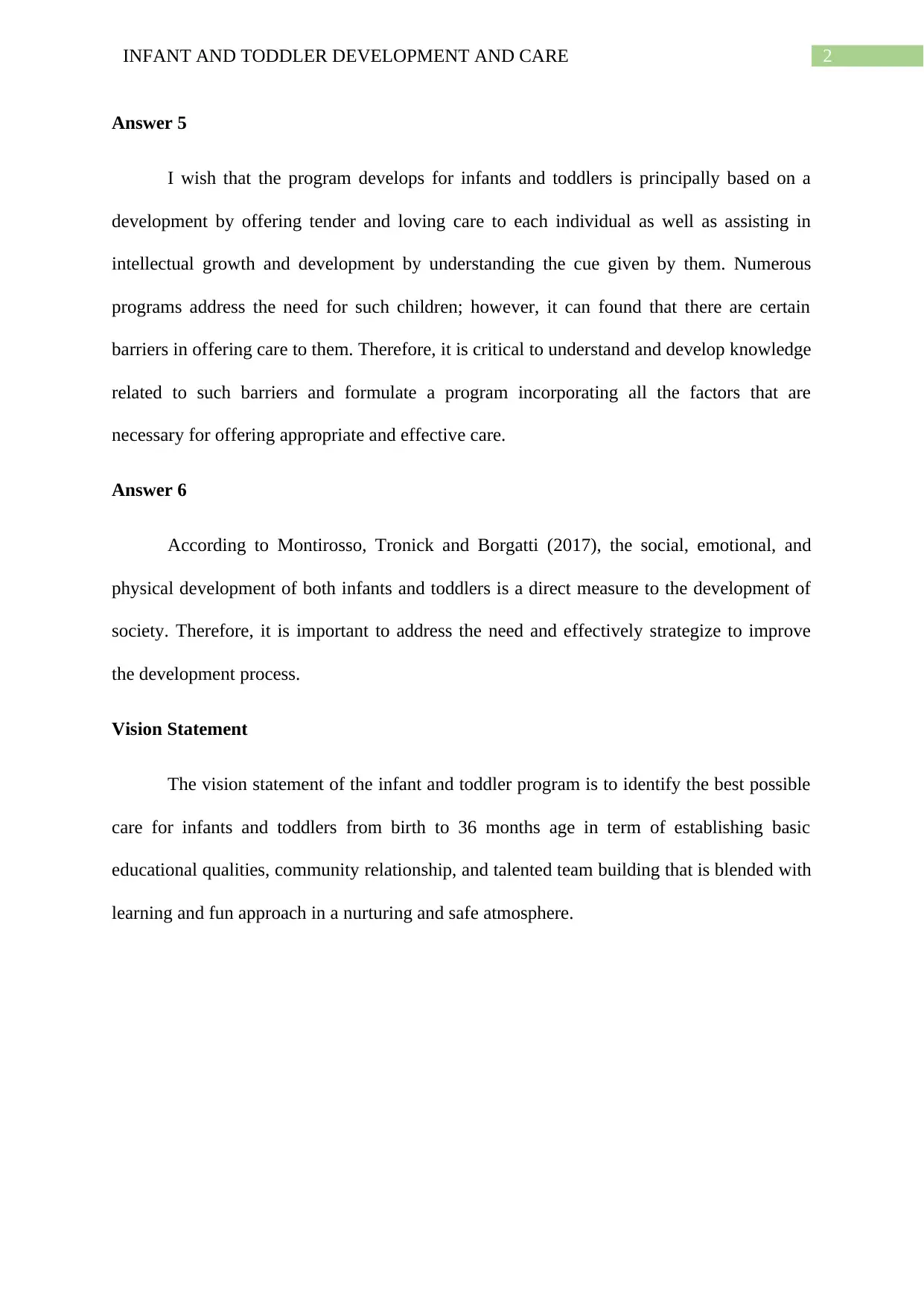
2INFANT AND TODDLER DEVELOPMENT AND CARE
Answer 5
I wish that the program develops for infants and toddlers is principally based on a
development by offering tender and loving care to each individual as well as assisting in
intellectual growth and development by understanding the cue given by them. Numerous
programs address the need for such children; however, it can found that there are certain
barriers in offering care to them. Therefore, it is critical to understand and develop knowledge
related to such barriers and formulate a program incorporating all the factors that are
necessary for offering appropriate and effective care.
Answer 6
According to Montirosso, Tronick and Borgatti (2017), the social, emotional, and
physical development of both infants and toddlers is a direct measure to the development of
society. Therefore, it is important to address the need and effectively strategize to improve
the development process.
Vision Statement
The vision statement of the infant and toddler program is to identify the best possible
care for infants and toddlers from birth to 36 months age in term of establishing basic
educational qualities, community relationship, and talented team building that is blended with
learning and fun approach in a nurturing and safe atmosphere.
Answer 5
I wish that the program develops for infants and toddlers is principally based on a
development by offering tender and loving care to each individual as well as assisting in
intellectual growth and development by understanding the cue given by them. Numerous
programs address the need for such children; however, it can found that there are certain
barriers in offering care to them. Therefore, it is critical to understand and develop knowledge
related to such barriers and formulate a program incorporating all the factors that are
necessary for offering appropriate and effective care.
Answer 6
According to Montirosso, Tronick and Borgatti (2017), the social, emotional, and
physical development of both infants and toddlers is a direct measure to the development of
society. Therefore, it is important to address the need and effectively strategize to improve
the development process.
Vision Statement
The vision statement of the infant and toddler program is to identify the best possible
care for infants and toddlers from birth to 36 months age in term of establishing basic
educational qualities, community relationship, and talented team building that is blended with
learning and fun approach in a nurturing and safe atmosphere.
⊘ This is a preview!⊘
Do you want full access?
Subscribe today to unlock all pages.

Trusted by 1+ million students worldwide
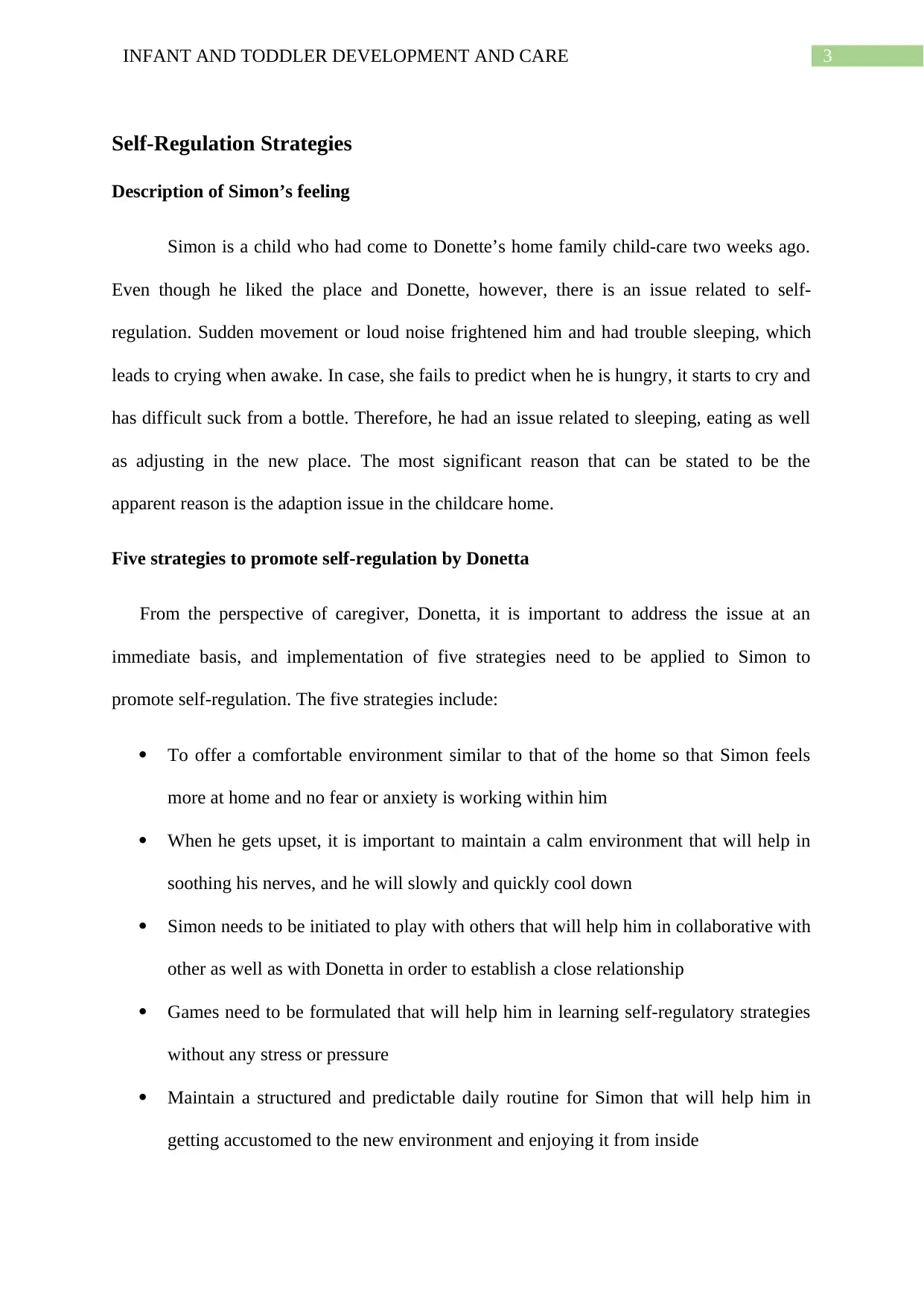
3INFANT AND TODDLER DEVELOPMENT AND CARE
Self-Regulation Strategies
Description of Simon’s feeling
Simon is a child who had come to Donette’s home family child-care two weeks ago.
Even though he liked the place and Donette, however, there is an issue related to self-
regulation. Sudden movement or loud noise frightened him and had trouble sleeping, which
leads to crying when awake. In case, she fails to predict when he is hungry, it starts to cry and
has difficult suck from a bottle. Therefore, he had an issue related to sleeping, eating as well
as adjusting in the new place. The most significant reason that can be stated to be the
apparent reason is the adaption issue in the childcare home.
Five strategies to promote self-regulation by Donetta
From the perspective of caregiver, Donetta, it is important to address the issue at an
immediate basis, and implementation of five strategies need to be applied to Simon to
promote self-regulation. The five strategies include:
To offer a comfortable environment similar to that of the home so that Simon feels
more at home and no fear or anxiety is working within him
When he gets upset, it is important to maintain a calm environment that will help in
soothing his nerves, and he will slowly and quickly cool down
Simon needs to be initiated to play with others that will help him in collaborative with
other as well as with Donetta in order to establish a close relationship
Games need to be formulated that will help him in learning self-regulatory strategies
without any stress or pressure
Maintain a structured and predictable daily routine for Simon that will help him in
getting accustomed to the new environment and enjoying it from inside
Self-Regulation Strategies
Description of Simon’s feeling
Simon is a child who had come to Donette’s home family child-care two weeks ago.
Even though he liked the place and Donette, however, there is an issue related to self-
regulation. Sudden movement or loud noise frightened him and had trouble sleeping, which
leads to crying when awake. In case, she fails to predict when he is hungry, it starts to cry and
has difficult suck from a bottle. Therefore, he had an issue related to sleeping, eating as well
as adjusting in the new place. The most significant reason that can be stated to be the
apparent reason is the adaption issue in the childcare home.
Five strategies to promote self-regulation by Donetta
From the perspective of caregiver, Donetta, it is important to address the issue at an
immediate basis, and implementation of five strategies need to be applied to Simon to
promote self-regulation. The five strategies include:
To offer a comfortable environment similar to that of the home so that Simon feels
more at home and no fear or anxiety is working within him
When he gets upset, it is important to maintain a calm environment that will help in
soothing his nerves, and he will slowly and quickly cool down
Simon needs to be initiated to play with others that will help him in collaborative with
other as well as with Donetta in order to establish a close relationship
Games need to be formulated that will help him in learning self-regulatory strategies
without any stress or pressure
Maintain a structured and predictable daily routine for Simon that will help him in
getting accustomed to the new environment and enjoying it from inside
Paraphrase This Document
Need a fresh take? Get an instant paraphrase of this document with our AI Paraphraser
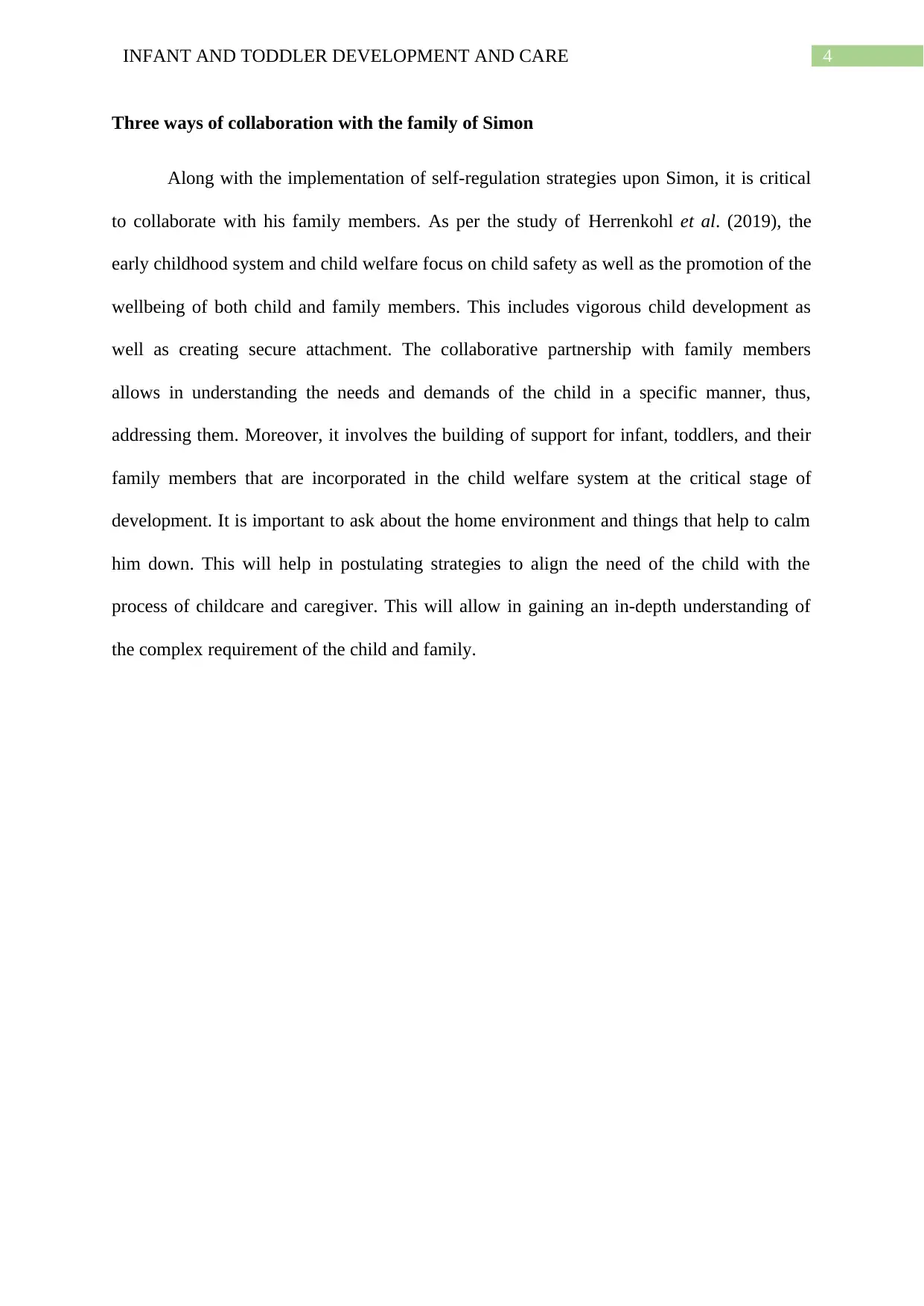
4INFANT AND TODDLER DEVELOPMENT AND CARE
Three ways of collaboration with the family of Simon
Along with the implementation of self-regulation strategies upon Simon, it is critical
to collaborate with his family members. As per the study of Herrenkohl et al. (2019), the
early childhood system and child welfare focus on child safety as well as the promotion of the
wellbeing of both child and family members. This includes vigorous child development as
well as creating secure attachment. The collaborative partnership with family members
allows in understanding the needs and demands of the child in a specific manner, thus,
addressing them. Moreover, it involves the building of support for infant, toddlers, and their
family members that are incorporated in the child welfare system at the critical stage of
development. It is important to ask about the home environment and things that help to calm
him down. This will help in postulating strategies to align the need of the child with the
process of childcare and caregiver. This will allow in gaining an in-depth understanding of
the complex requirement of the child and family.
Three ways of collaboration with the family of Simon
Along with the implementation of self-regulation strategies upon Simon, it is critical
to collaborate with his family members. As per the study of Herrenkohl et al. (2019), the
early childhood system and child welfare focus on child safety as well as the promotion of the
wellbeing of both child and family members. This includes vigorous child development as
well as creating secure attachment. The collaborative partnership with family members
allows in understanding the needs and demands of the child in a specific manner, thus,
addressing them. Moreover, it involves the building of support for infant, toddlers, and their
family members that are incorporated in the child welfare system at the critical stage of
development. It is important to ask about the home environment and things that help to calm
him down. This will help in postulating strategies to align the need of the child with the
process of childcare and caregiver. This will allow in gaining an in-depth understanding of
the complex requirement of the child and family.
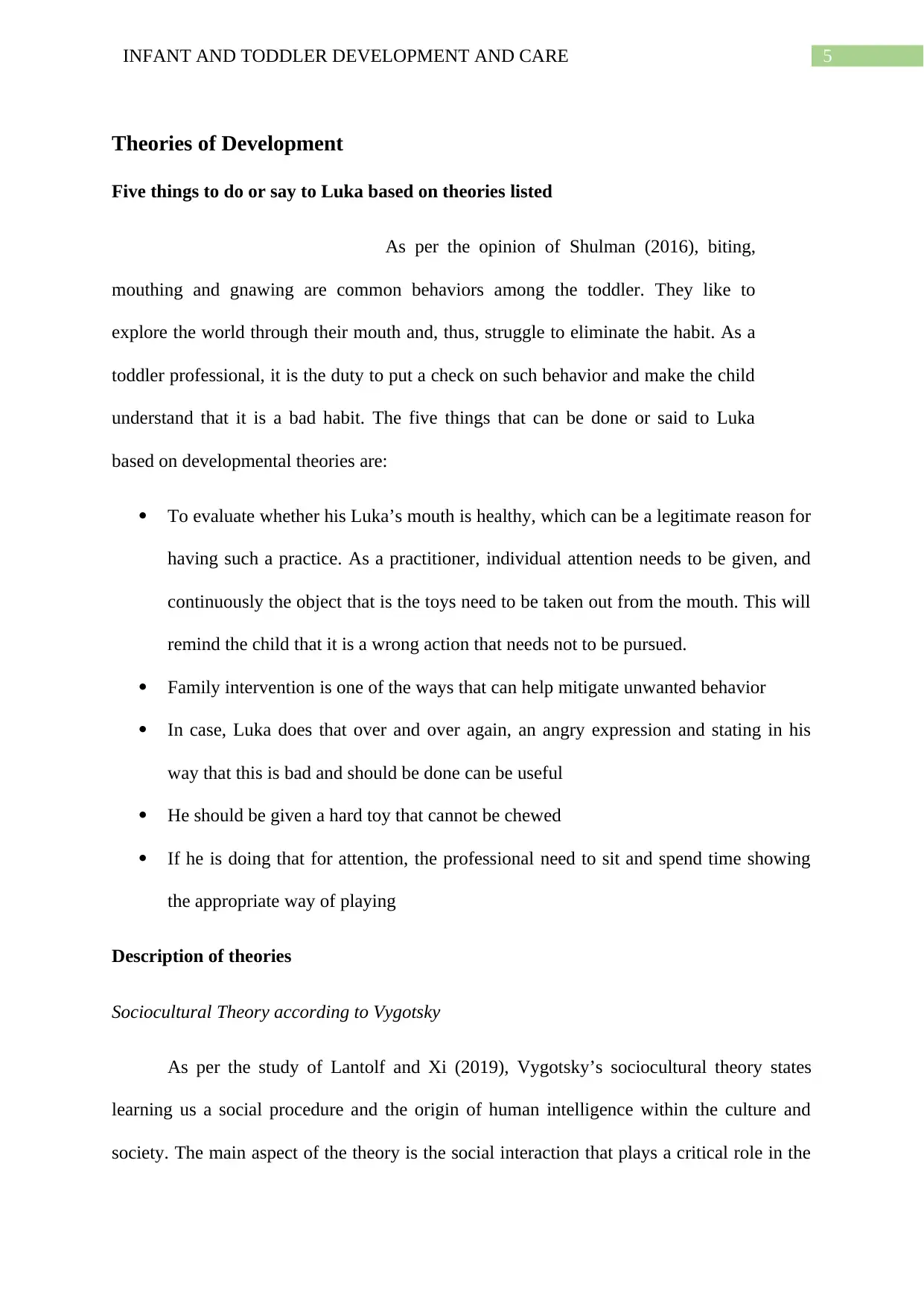
5INFANT AND TODDLER DEVELOPMENT AND CARE
Theories of Development
Five things to do or say to Luka based on theories listed
As per the opinion of Shulman (2016), biting,
mouthing and gnawing are common behaviors among the toddler. They like to
explore the world through their mouth and, thus, struggle to eliminate the habit. As a
toddler professional, it is the duty to put a check on such behavior and make the child
understand that it is a bad habit. The five things that can be done or said to Luka
based on developmental theories are:
To evaluate whether his Luka’s mouth is healthy, which can be a legitimate reason for
having such a practice. As a practitioner, individual attention needs to be given, and
continuously the object that is the toys need to be taken out from the mouth. This will
remind the child that it is a wrong action that needs not to be pursued.
Family intervention is one of the ways that can help mitigate unwanted behavior
In case, Luka does that over and over again, an angry expression and stating in his
way that this is bad and should be done can be useful
He should be given a hard toy that cannot be chewed
If he is doing that for attention, the professional need to sit and spend time showing
the appropriate way of playing
Description of theories
Sociocultural Theory according to Vygotsky
As per the study of Lantolf and Xi (2019), Vygotsky’s sociocultural theory states
learning us a social procedure and the origin of human intelligence within the culture and
society. The main aspect of the theory is the social interaction that plays a critical role in the
Theories of Development
Five things to do or say to Luka based on theories listed
As per the opinion of Shulman (2016), biting,
mouthing and gnawing are common behaviors among the toddler. They like to
explore the world through their mouth and, thus, struggle to eliminate the habit. As a
toddler professional, it is the duty to put a check on such behavior and make the child
understand that it is a bad habit. The five things that can be done or said to Luka
based on developmental theories are:
To evaluate whether his Luka’s mouth is healthy, which can be a legitimate reason for
having such a practice. As a practitioner, individual attention needs to be given, and
continuously the object that is the toys need to be taken out from the mouth. This will
remind the child that it is a wrong action that needs not to be pursued.
Family intervention is one of the ways that can help mitigate unwanted behavior
In case, Luka does that over and over again, an angry expression and stating in his
way that this is bad and should be done can be useful
He should be given a hard toy that cannot be chewed
If he is doing that for attention, the professional need to sit and spend time showing
the appropriate way of playing
Description of theories
Sociocultural Theory according to Vygotsky
As per the study of Lantolf and Xi (2019), Vygotsky’s sociocultural theory states
learning us a social procedure and the origin of human intelligence within the culture and
society. The main aspect of the theory is the social interaction that plays a critical role in the
⊘ This is a preview!⊘
Do you want full access?
Subscribe today to unlock all pages.

Trusted by 1+ million students worldwide
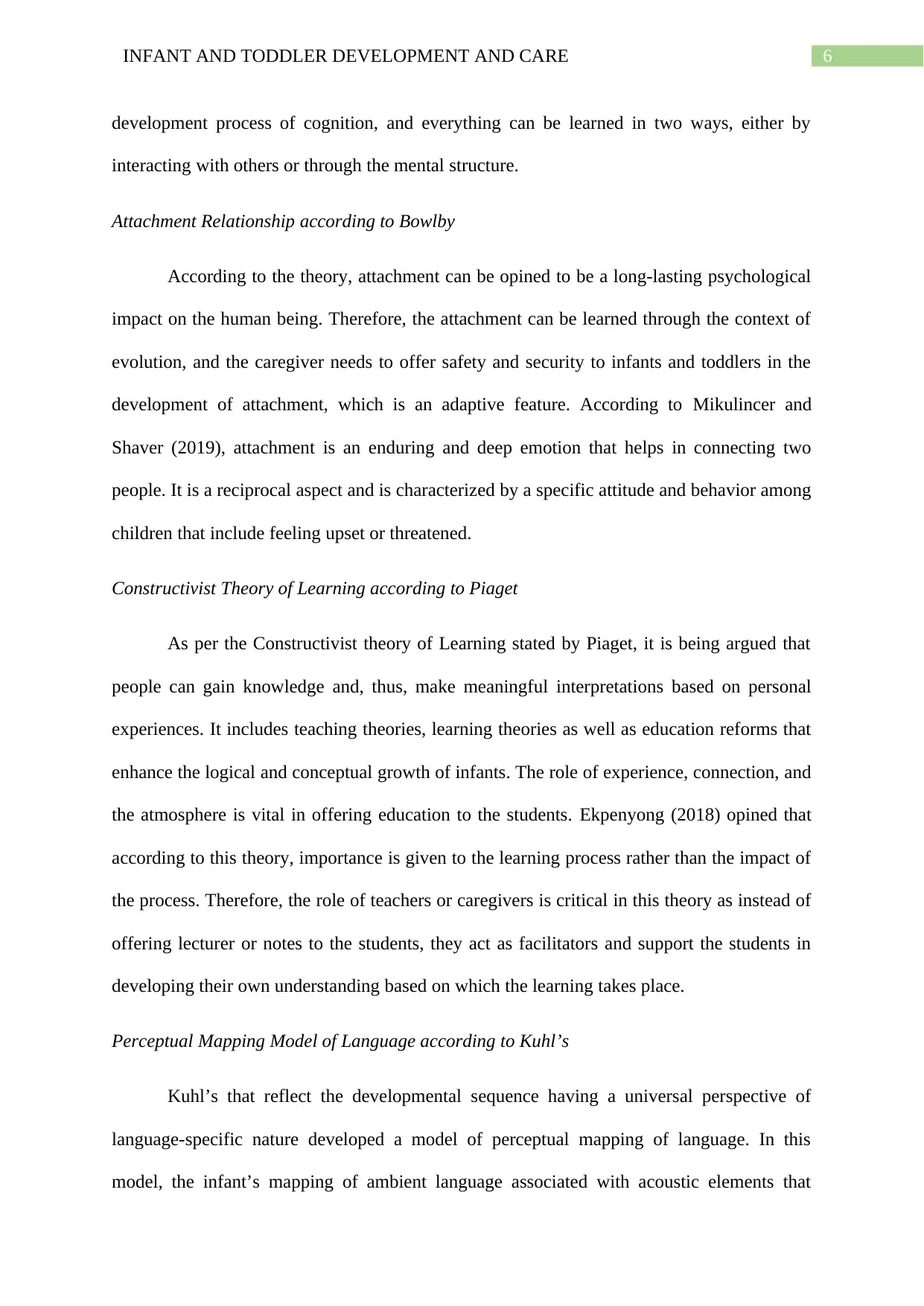
6INFANT AND TODDLER DEVELOPMENT AND CARE
development process of cognition, and everything can be learned in two ways, either by
interacting with others or through the mental structure.
Attachment Relationship according to Bowlby
According to the theory, attachment can be opined to be a long-lasting psychological
impact on the human being. Therefore, the attachment can be learned through the context of
evolution, and the caregiver needs to offer safety and security to infants and toddlers in the
development of attachment, which is an adaptive feature. According to Mikulincer and
Shaver (2019), attachment is an enduring and deep emotion that helps in connecting two
people. It is a reciprocal aspect and is characterized by a specific attitude and behavior among
children that include feeling upset or threatened.
Constructivist Theory of Learning according to Piaget
As per the Constructivist theory of Learning stated by Piaget, it is being argued that
people can gain knowledge and, thus, make meaningful interpretations based on personal
experiences. It includes teaching theories, learning theories as well as education reforms that
enhance the logical and conceptual growth of infants. The role of experience, connection, and
the atmosphere is vital in offering education to the students. Ekpenyong (2018) opined that
according to this theory, importance is given to the learning process rather than the impact of
the process. Therefore, the role of teachers or caregivers is critical in this theory as instead of
offering lecturer or notes to the students, they act as facilitators and support the students in
developing their own understanding based on which the learning takes place.
Perceptual Mapping Model of Language according to Kuhl’s
Kuhl’s that reflect the developmental sequence having a universal perspective of
language-specific nature developed a model of perceptual mapping of language. In this
model, the infant’s mapping of ambient language associated with acoustic elements that
development process of cognition, and everything can be learned in two ways, either by
interacting with others or through the mental structure.
Attachment Relationship according to Bowlby
According to the theory, attachment can be opined to be a long-lasting psychological
impact on the human being. Therefore, the attachment can be learned through the context of
evolution, and the caregiver needs to offer safety and security to infants and toddlers in the
development of attachment, which is an adaptive feature. According to Mikulincer and
Shaver (2019), attachment is an enduring and deep emotion that helps in connecting two
people. It is a reciprocal aspect and is characterized by a specific attitude and behavior among
children that include feeling upset or threatened.
Constructivist Theory of Learning according to Piaget
As per the Constructivist theory of Learning stated by Piaget, it is being argued that
people can gain knowledge and, thus, make meaningful interpretations based on personal
experiences. It includes teaching theories, learning theories as well as education reforms that
enhance the logical and conceptual growth of infants. The role of experience, connection, and
the atmosphere is vital in offering education to the students. Ekpenyong (2018) opined that
according to this theory, importance is given to the learning process rather than the impact of
the process. Therefore, the role of teachers or caregivers is critical in this theory as instead of
offering lecturer or notes to the students, they act as facilitators and support the students in
developing their own understanding based on which the learning takes place.
Perceptual Mapping Model of Language according to Kuhl’s
Kuhl’s that reflect the developmental sequence having a universal perspective of
language-specific nature developed a model of perceptual mapping of language. In this
model, the infant’s mapping of ambient language associated with acoustic elements that
Paraphrase This Document
Need a fresh take? Get an instant paraphrase of this document with our AI Paraphraser
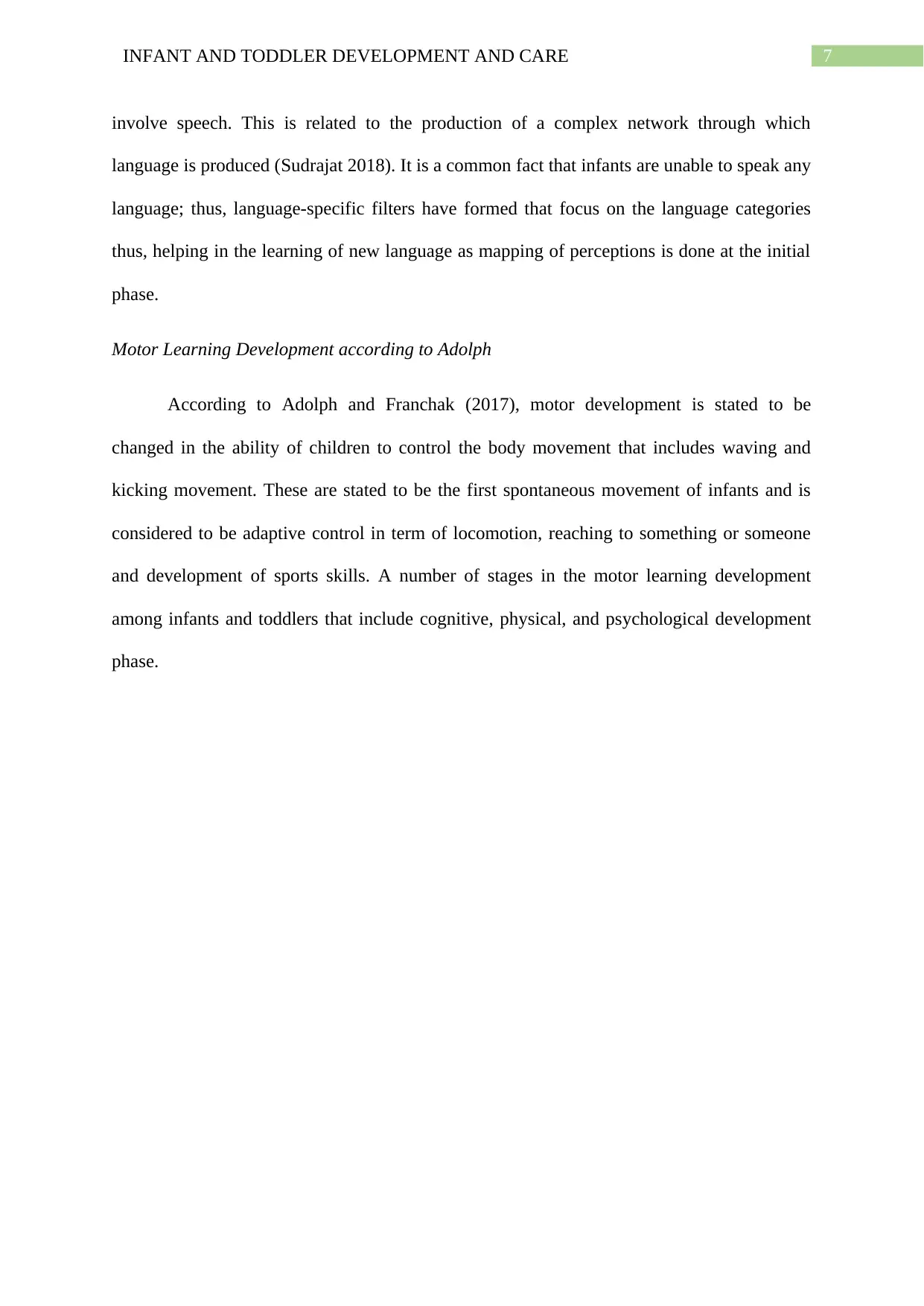
7INFANT AND TODDLER DEVELOPMENT AND CARE
involve speech. This is related to the production of a complex network through which
language is produced (Sudrajat 2018). It is a common fact that infants are unable to speak any
language; thus, language-specific filters have formed that focus on the language categories
thus, helping in the learning of new language as mapping of perceptions is done at the initial
phase.
Motor Learning Development according to Adolph
According to Adolph and Franchak (2017), motor development is stated to be
changed in the ability of children to control the body movement that includes waving and
kicking movement. These are stated to be the first spontaneous movement of infants and is
considered to be adaptive control in term of locomotion, reaching to something or someone
and development of sports skills. A number of stages in the motor learning development
among infants and toddlers that include cognitive, physical, and psychological development
phase.
involve speech. This is related to the production of a complex network through which
language is produced (Sudrajat 2018). It is a common fact that infants are unable to speak any
language; thus, language-specific filters have formed that focus on the language categories
thus, helping in the learning of new language as mapping of perceptions is done at the initial
phase.
Motor Learning Development according to Adolph
According to Adolph and Franchak (2017), motor development is stated to be
changed in the ability of children to control the body movement that includes waving and
kicking movement. These are stated to be the first spontaneous movement of infants and is
considered to be adaptive control in term of locomotion, reaching to something or someone
and development of sports skills. A number of stages in the motor learning development
among infants and toddlers that include cognitive, physical, and psychological development
phase.
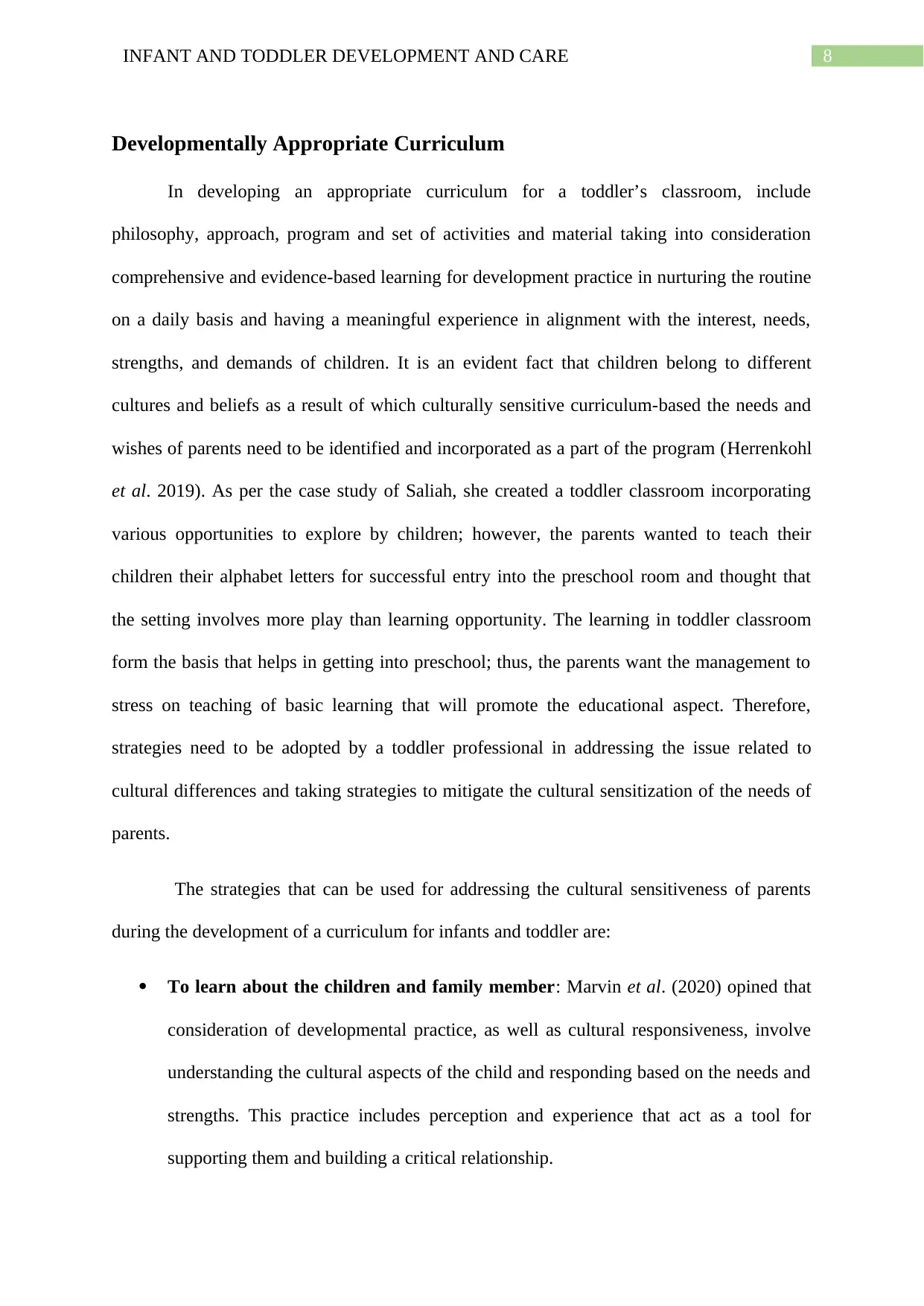
8INFANT AND TODDLER DEVELOPMENT AND CARE
Developmentally Appropriate Curriculum
In developing an appropriate curriculum for a toddler’s classroom, include
philosophy, approach, program and set of activities and material taking into consideration
comprehensive and evidence-based learning for development practice in nurturing the routine
on a daily basis and having a meaningful experience in alignment with the interest, needs,
strengths, and demands of children. It is an evident fact that children belong to different
cultures and beliefs as a result of which culturally sensitive curriculum-based the needs and
wishes of parents need to be identified and incorporated as a part of the program (Herrenkohl
et al. 2019). As per the case study of Saliah, she created a toddler classroom incorporating
various opportunities to explore by children; however, the parents wanted to teach their
children their alphabet letters for successful entry into the preschool room and thought that
the setting involves more play than learning opportunity. The learning in toddler classroom
form the basis that helps in getting into preschool; thus, the parents want the management to
stress on teaching of basic learning that will promote the educational aspect. Therefore,
strategies need to be adopted by a toddler professional in addressing the issue related to
cultural differences and taking strategies to mitigate the cultural sensitization of the needs of
parents.
The strategies that can be used for addressing the cultural sensitiveness of parents
during the development of a curriculum for infants and toddler are:
To learn about the children and family member: Marvin et al. (2020) opined that
consideration of developmental practice, as well as cultural responsiveness, involve
understanding the cultural aspects of the child and responding based on the needs and
strengths. This practice includes perception and experience that act as a tool for
supporting them and building a critical relationship.
Developmentally Appropriate Curriculum
In developing an appropriate curriculum for a toddler’s classroom, include
philosophy, approach, program and set of activities and material taking into consideration
comprehensive and evidence-based learning for development practice in nurturing the routine
on a daily basis and having a meaningful experience in alignment with the interest, needs,
strengths, and demands of children. It is an evident fact that children belong to different
cultures and beliefs as a result of which culturally sensitive curriculum-based the needs and
wishes of parents need to be identified and incorporated as a part of the program (Herrenkohl
et al. 2019). As per the case study of Saliah, she created a toddler classroom incorporating
various opportunities to explore by children; however, the parents wanted to teach their
children their alphabet letters for successful entry into the preschool room and thought that
the setting involves more play than learning opportunity. The learning in toddler classroom
form the basis that helps in getting into preschool; thus, the parents want the management to
stress on teaching of basic learning that will promote the educational aspect. Therefore,
strategies need to be adopted by a toddler professional in addressing the issue related to
cultural differences and taking strategies to mitigate the cultural sensitization of the needs of
parents.
The strategies that can be used for addressing the cultural sensitiveness of parents
during the development of a curriculum for infants and toddler are:
To learn about the children and family member: Marvin et al. (2020) opined that
consideration of developmental practice, as well as cultural responsiveness, involve
understanding the cultural aspects of the child and responding based on the needs and
strengths. This practice includes perception and experience that act as a tool for
supporting them and building a critical relationship.
⊘ This is a preview!⊘
Do you want full access?
Subscribe today to unlock all pages.

Trusted by 1+ million students worldwide
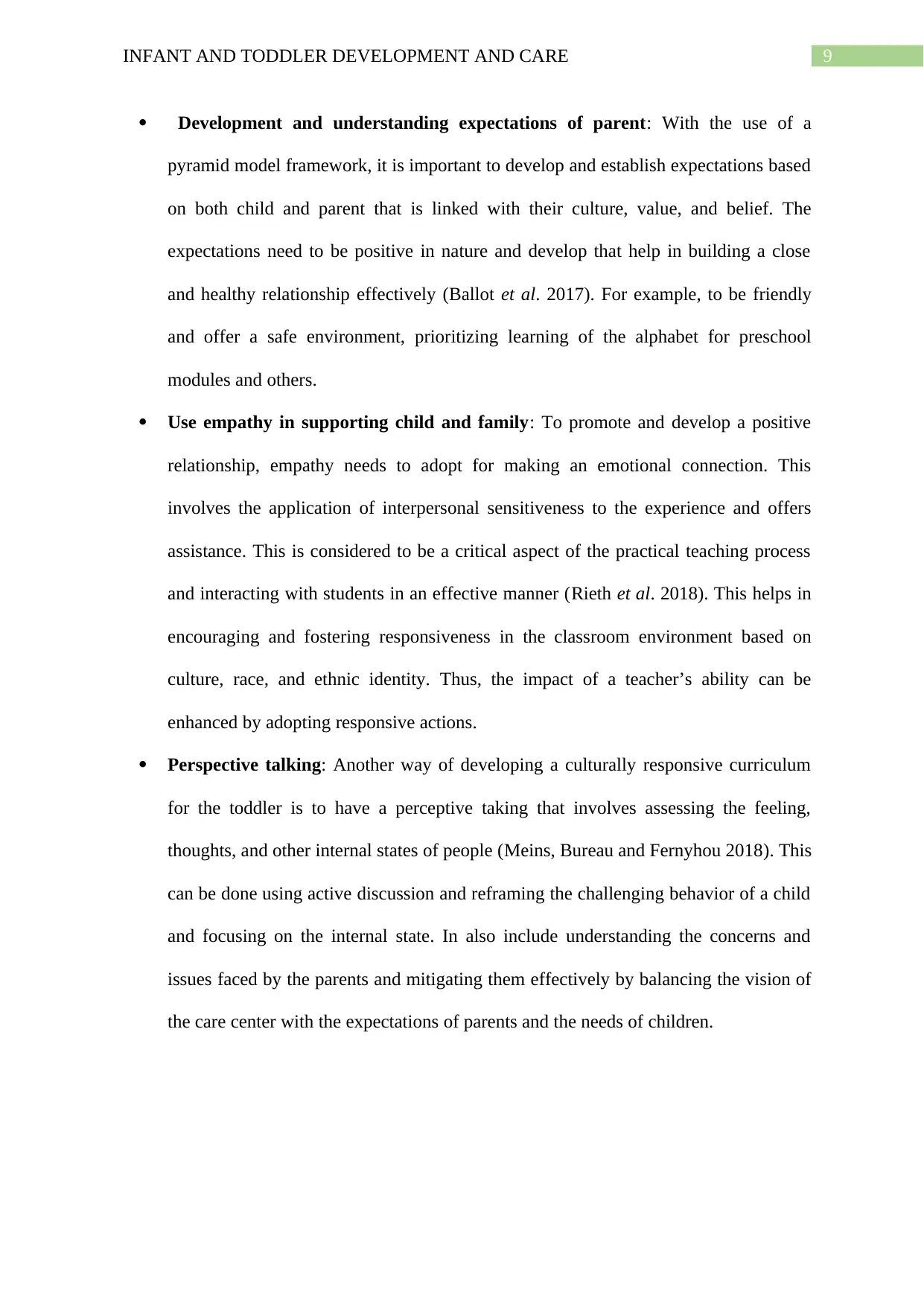
9INFANT AND TODDLER DEVELOPMENT AND CARE
Development and understanding expectations of parent: With the use of a
pyramid model framework, it is important to develop and establish expectations based
on both child and parent that is linked with their culture, value, and belief. The
expectations need to be positive in nature and develop that help in building a close
and healthy relationship effectively (Ballot et al. 2017). For example, to be friendly
and offer a safe environment, prioritizing learning of the alphabet for preschool
modules and others.
Use empathy in supporting child and family: To promote and develop a positive
relationship, empathy needs to adopt for making an emotional connection. This
involves the application of interpersonal sensitiveness to the experience and offers
assistance. This is considered to be a critical aspect of the practical teaching process
and interacting with students in an effective manner (Rieth et al. 2018). This helps in
encouraging and fostering responsiveness in the classroom environment based on
culture, race, and ethnic identity. Thus, the impact of a teacher’s ability can be
enhanced by adopting responsive actions.
Perspective talking: Another way of developing a culturally responsive curriculum
for the toddler is to have a perceptive taking that involves assessing the feeling,
thoughts, and other internal states of people (Meins, Bureau and Fernyhou 2018). This
can be done using active discussion and reframing the challenging behavior of a child
and focusing on the internal state. In also include understanding the concerns and
issues faced by the parents and mitigating them effectively by balancing the vision of
the care center with the expectations of parents and the needs of children.
Development and understanding expectations of parent: With the use of a
pyramid model framework, it is important to develop and establish expectations based
on both child and parent that is linked with their culture, value, and belief. The
expectations need to be positive in nature and develop that help in building a close
and healthy relationship effectively (Ballot et al. 2017). For example, to be friendly
and offer a safe environment, prioritizing learning of the alphabet for preschool
modules and others.
Use empathy in supporting child and family: To promote and develop a positive
relationship, empathy needs to adopt for making an emotional connection. This
involves the application of interpersonal sensitiveness to the experience and offers
assistance. This is considered to be a critical aspect of the practical teaching process
and interacting with students in an effective manner (Rieth et al. 2018). This helps in
encouraging and fostering responsiveness in the classroom environment based on
culture, race, and ethnic identity. Thus, the impact of a teacher’s ability can be
enhanced by adopting responsive actions.
Perspective talking: Another way of developing a culturally responsive curriculum
for the toddler is to have a perceptive taking that involves assessing the feeling,
thoughts, and other internal states of people (Meins, Bureau and Fernyhou 2018). This
can be done using active discussion and reframing the challenging behavior of a child
and focusing on the internal state. In also include understanding the concerns and
issues faced by the parents and mitigating them effectively by balancing the vision of
the care center with the expectations of parents and the needs of children.
Paraphrase This Document
Need a fresh take? Get an instant paraphrase of this document with our AI Paraphraser
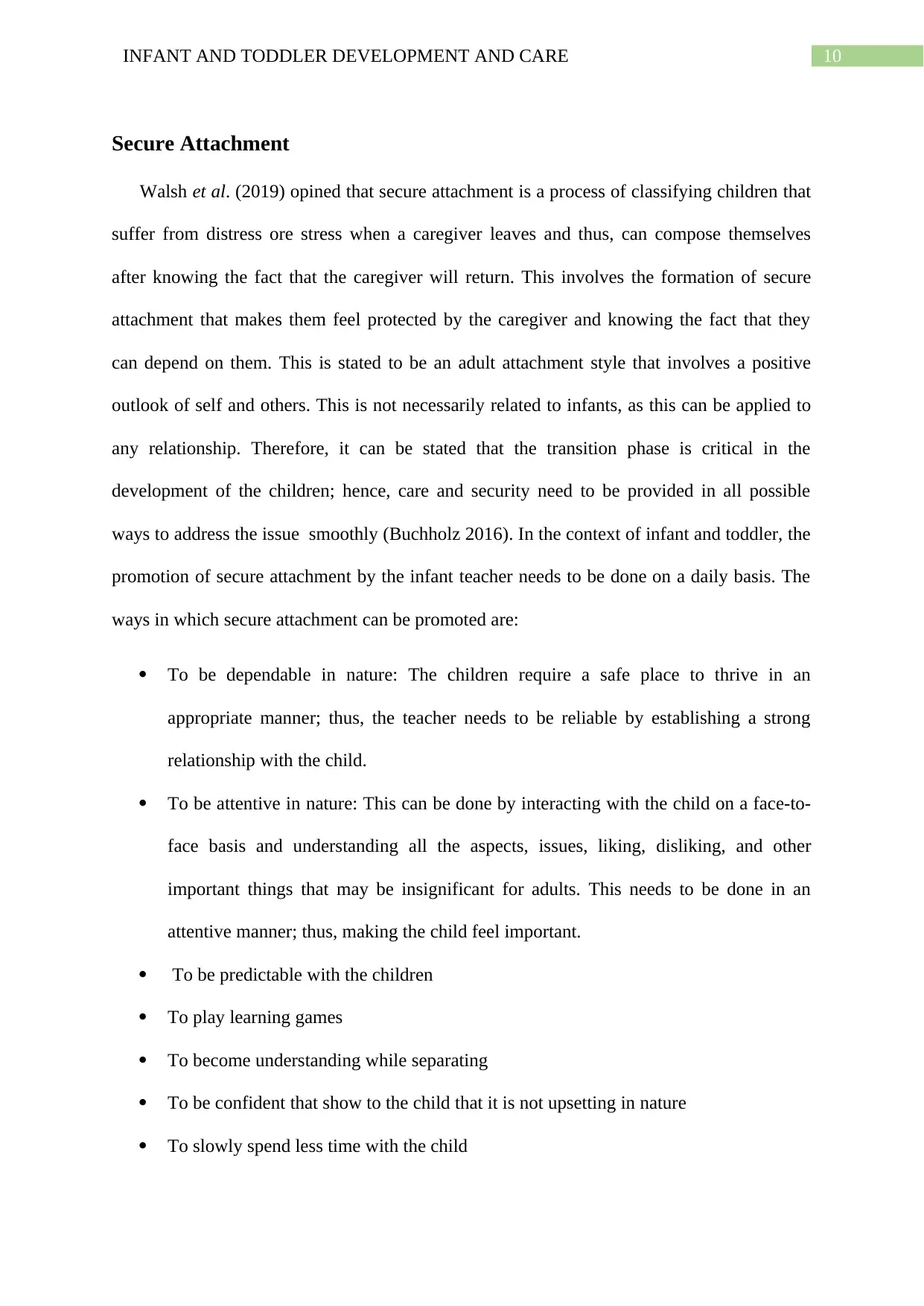
10INFANT AND TODDLER DEVELOPMENT AND CARE
Secure Attachment
Walsh et al. (2019) opined that secure attachment is a process of classifying children that
suffer from distress ore stress when a caregiver leaves and thus, can compose themselves
after knowing the fact that the caregiver will return. This involves the formation of secure
attachment that makes them feel protected by the caregiver and knowing the fact that they
can depend on them. This is stated to be an adult attachment style that involves a positive
outlook of self and others. This is not necessarily related to infants, as this can be applied to
any relationship. Therefore, it can be stated that the transition phase is critical in the
development of the children; hence, care and security need to be provided in all possible
ways to address the issue smoothly (Buchholz 2016). In the context of infant and toddler, the
promotion of secure attachment by the infant teacher needs to be done on a daily basis. The
ways in which secure attachment can be promoted are:
To be dependable in nature: The children require a safe place to thrive in an
appropriate manner; thus, the teacher needs to be reliable by establishing a strong
relationship with the child.
To be attentive in nature: This can be done by interacting with the child on a face-to-
face basis and understanding all the aspects, issues, liking, disliking, and other
important things that may be insignificant for adults. This needs to be done in an
attentive manner; thus, making the child feel important.
To be predictable with the children
To play learning games
To become understanding while separating
To be confident that show to the child that it is not upsetting in nature
To slowly spend less time with the child
Secure Attachment
Walsh et al. (2019) opined that secure attachment is a process of classifying children that
suffer from distress ore stress when a caregiver leaves and thus, can compose themselves
after knowing the fact that the caregiver will return. This involves the formation of secure
attachment that makes them feel protected by the caregiver and knowing the fact that they
can depend on them. This is stated to be an adult attachment style that involves a positive
outlook of self and others. This is not necessarily related to infants, as this can be applied to
any relationship. Therefore, it can be stated that the transition phase is critical in the
development of the children; hence, care and security need to be provided in all possible
ways to address the issue smoothly (Buchholz 2016). In the context of infant and toddler, the
promotion of secure attachment by the infant teacher needs to be done on a daily basis. The
ways in which secure attachment can be promoted are:
To be dependable in nature: The children require a safe place to thrive in an
appropriate manner; thus, the teacher needs to be reliable by establishing a strong
relationship with the child.
To be attentive in nature: This can be done by interacting with the child on a face-to-
face basis and understanding all the aspects, issues, liking, disliking, and other
important things that may be insignificant for adults. This needs to be done in an
attentive manner; thus, making the child feel important.
To be predictable with the children
To play learning games
To become understanding while separating
To be confident that show to the child that it is not upsetting in nature
To slowly spend less time with the child
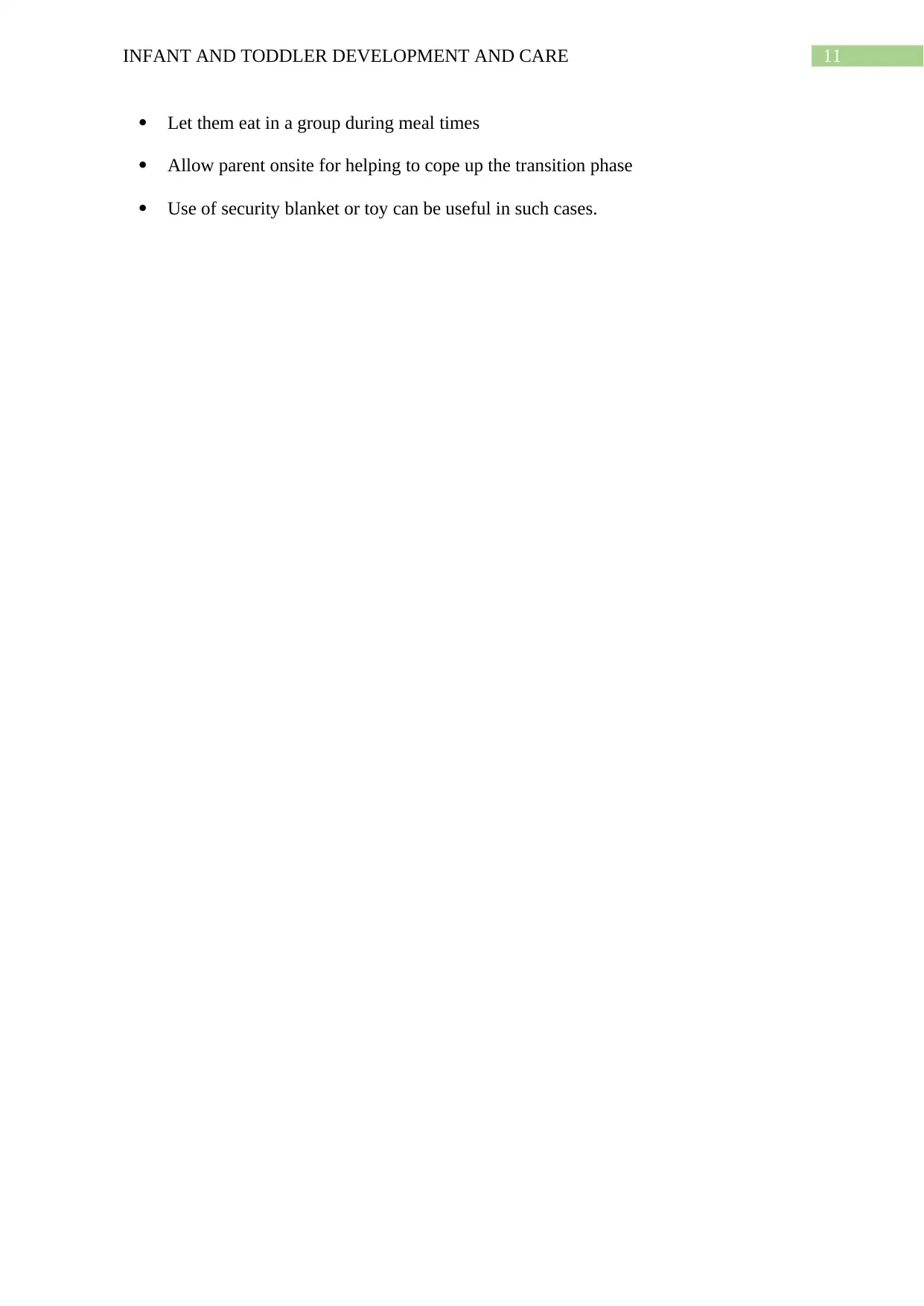
11INFANT AND TODDLER DEVELOPMENT AND CARE
Let them eat in a group during meal times
Allow parent onsite for helping to cope up the transition phase
Use of security blanket or toy can be useful in such cases.
Let them eat in a group during meal times
Allow parent onsite for helping to cope up the transition phase
Use of security blanket or toy can be useful in such cases.
⊘ This is a preview!⊘
Do you want full access?
Subscribe today to unlock all pages.

Trusted by 1+ million students worldwide
1 out of 15
Related Documents
Your All-in-One AI-Powered Toolkit for Academic Success.
+13062052269
info@desklib.com
Available 24*7 on WhatsApp / Email
![[object Object]](/_next/static/media/star-bottom.7253800d.svg)
Unlock your academic potential
Copyright © 2020–2025 A2Z Services. All Rights Reserved. Developed and managed by ZUCOL.





